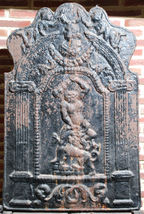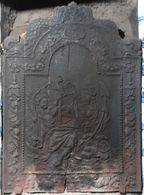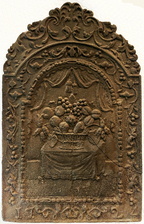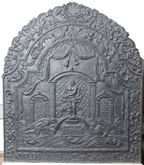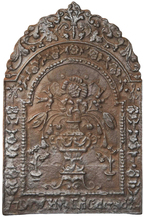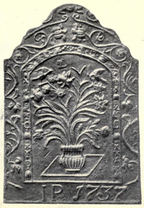-
257
Description: Arched rectangular central panel with ‘nutshell’ edging on a broad fillet; crowned figure, holding a sceptre in his right hand, sitting in a chariot drawn to the left by two horses with ostrich feather head-dresses; the whole upon a causeway with pilasters and masonry, and waves beneath; a heron flying to the left; above, swagged drapery with two tassels hanging from the centre; arched rectangular shaped border with fillet edging, symmetrical, flower bunches, descending from a ribbon loop; monogram centre bottom, between plant tendrils; on top, symmetrical scrolled plant tendrils.
Notes: The design is derived from a personification of Europe, one of a set of playing cards entitled 'Jeu de la Géographie', designed by Stefano della Bella (1677); a similarity with Queen Anne may not be coincidental; the flying heron has been copied from a print by Wenceslaus Hollar c.1658.
Copies of this fireback are known.
Inscription: SHR
Manufactured: in the late-17th to early-18th century in England.
Current location: Chiddingstone Castle, Chiddingstone, Kent, England.
- Attached to series:
- SHR series
- British 'Dutch' style firebacks
-
1221
 ? x ? mm
? x ? mmDescription: Arched rectangular central panel with bead on broad fillet edging; lattice basket standing on a ground, with flowers and fruit issuing therefrom in a symmetrical display; arched rectangular border with fillet edging; on each side, mirrored vine with flowers and leaves suspended from mirrored swirled foliage; at the bottom, the letter W in a cartouche between swirled foliage; on top, mirrored swirled foliage issuing upwards from a mythical creature on each shoulder.
Notes: The floral theme and its execution shows parallels with the SHR, N and 1724 series of firebacks and could be from the same workshop. The 'W' initial probably denotes the pattern maker.
Inscription: W
Manufactured: in the late-17th to early-18th century in England.
Current location: not known.
Citation: Anon., 2 Dec 1905, 'Old Kent and Sussex Fire-backs', Country Life, pp. 767-768.
- Attached to series:
- W series
- British 'Dutch' style firebacks
- Fruit basket firebacks
-
1026
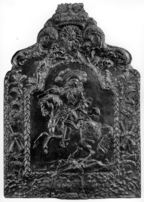 ? x ? mm
? x ? mmDescription: Arched rectangular central panel with overlapping leaf bud edging; prancing equestrian figure of a man in late-seventeenth century dress, with a plumed tricorn hat, his head turned to his left, his left hand holding the reins and his right hand pointing a baton beside the horse's head; quasi-arched rectangular border with overlapping leaf bud edging enclosing martial emblems (cannon, helmets etc.) to left and right, and surmounted by two reclining female figures, that to the left blowing a hunting horn, and that to the right supporting a cornucopia; between them, a sun in splendour, above which is a royal crown; at the bottom corrosion through use and damage has rendered the decoration indistinct.
Notes: The sun in splendour suggests that the figure is that of Louis XIV, of France, but the 'Dutch' style makes this less likely; an alternative identification might be Crown Prince Frederick (later King Frederick IV) of Denmark, of whom other fireback representations exist in a similar pose and with similar martial accoutriments.
- Decoration tags:
- 'Dutch' (shape)
- overlapping leaf bud (edging)
- whole carved pattern
- pictorial
- royal
- animals
- humans
- objects
Manufactured: in the late-17th century in Germany.
Current location:, not known.
- Attached to series:
- 'Dutch' Miscellaneous Firebacks
-
46
Description: Ionic columns supporting a semi-circular arch, in the centre of which the bust of a man has a floral swag beneath; below is a quasi-arched rectangle of beads within which is the figure of Hercules, wielding a club, slaying the Nemean Lion; beneath are floral scrolls; on top of the main arch two kneeling putti hold a wreath over the bust.
Notes: Not the standard 'Dutch' type, which may indicate a different origin.
Copies of this fireback are known.
- Decoration tags:
- 'Dutch' (shape)
- fillet (edging)
- whole carved pattern
- pictorial
- mythological
- animals
- humans
- objects
Manufactured: in the early- to mid-18th century in England.
Current location: in private hands, Cuckfield, West Sussex, England.
- Attached to series:
- Late pictorial series (all)
- Late pictorial series 6
-
42
Description: Arched rectangular shaped central panel with bead edging; pictorial scene of a seated female figure resting against a hurdle, holding an anchor, a child on each side of her, the one on the left standing clutching corn stalks, the one on the right sitting also holding the anchor and a circular object; a bird sits on a post; arched rectangular shaped border with fillet edging, containing floral swags suspended from a wreath; on top, a scallop shell between two dolphins.
Notes: The figure represents Hope. The theft in 1699 from a Thames-side warehouse of several firebacks, including '3 of Hope with an Anchor' may refer to this type (Post Boy 11-14 Nov. 1699).
Copies of this fireback are known.
- Decoration tags:
- 'Dutch' (shape)
- fillet (edging)
- whole carved pattern
- pictorial
- allegorical
- animals
- humans
- objects
Manufactured: in the mid- to late-17th century in the Siegerland area of Germany.
Current location: in private hands, Cuckfield, West Sussex, England.
- Attached to series:
- 'Dutch' Miscellaneous Firebacks
- Hope firebacks
-
1301
Description: Arched rectangular shaped central panel, bead-and-pellet on fillet edging; beneath swagged curtains, a basket containing a variety of fruit - plums, apples, pears and grapes - resting on a table draped with a fringed cloth; arched rectangular shaped border with fillet edging and symmetrical foliate tendrils; date in bottom corners split betwen foliate tendrils incorporating looped 'W' shapes; on top, symmetrical scrolled plant tendrils.
Notes: One of a series of firebacks made originally in 1724. The basket of fruit was probably inspired by still-life paintings by European artists of the first half of the 17th century. Formerly at Salem, Massachusetts.
Copies of this fireback are known.
Inscription: 17 24
Manufactured: in 1724 in England.
Current location: Historic Deerfield, 80 Old Main Street, Deerfield, Massachusetts, United States of America.
Museum number: HD 53.086 (part of the Historic Deerfield museum group)
- Attached to series:
- 1724 series
- British 'Dutch' style firebacks
- Fruit basket firebacks
-
271
Description: Arched rectangular shaped central panel with top corners cavetto canted, bead-and-pellet edging on a wide fillet; hanging drapery with central tassels over three low-arched cubicles, the two outer smaller than the centre, with Tuscan columns and overlapping scales behind; on a plinth of overlapping scales with a scallop shell behind, the standing figure of Neptune/Poseidon, holding a trident in his right hand; water issues from by his feet and from the waves below him disport two ‘sea horses’ and three dolphins; arched rectangular shaped border with top corners cavetto canted, fillet edging: suspended symmetrical beads with tassel ends decorated with sea shells; between two looped 'W' figures, the inscription separating halves of the date along the bottom; above, a central scallop shell with symmetrical floral scrolls on each side.
Notes: From a design in 'Nouveaux livres de ...Statues [etc.]' (La Haye & Amsterdam 1702-5), by Daniel Marot. The inscription, translated as 'GOD is our strength', is a paraphrase of Psalm 46: 1; the original wooden pattern is in Museum Rotterdam (no. 931}; an identical inscription and date is found on several firebacks. All incorporate the looped 'W' motif which may be intended to identify the pattern maker. Formerly at Dogwells Farmhouse, Corscombe, Dorset; other examples are at Leith Hill Place, Surrey, and Lower Brockhampton farmhouse, Herefordshire, the latter having originally been in Dunster Castle, Somerset.
Copies of this fireback are known.
Inscription: 17 DVW Ydyw Ein Cadernid 24
- Decoration tags:
- 'Dutch' (shape)
- fillet (edging)
- whole carved pattern
- pictorial
- mythological
- architectural
- text
- animals
- humans
- objects
Manufactured: in 1724 in England.
Current location: Dorset County Museum, Dorchester, Dorset, England.
(part of the Dorset County Museum museum group)
- Attached to series:
- 1724 series
- Welsh inscription series
- British 'Dutch' style firebacks
-
227
Description: Arched rectangular shaped central panel with bead edging on a wide fillet; two-handled vase with assorted flowers on a stand with scrolled legs; a plant pot on each side; arched rectangular shaped border with fillet edging, symmetrical floral fronds descending from a rose, top centre, with a looped 'W' in each shoulder; inscription at base; on top, symmetrical scrolled plant tendrils.
Notes: One of the two largest of six flower vase designs in this series. All incorporate the looped 'W' motif which may be intended to identify the pattern maker. The inscription, known from other firebacks in the series, translates as 'God is our strength'. Dore & Rees Auctions, Frome, 6 Dec 2024, lot 93 (£130).
Copies of this fireback are known.
Inscription: 17 DVW Ydyw Ein Cadernid 24
Manufactured: in 1724 in England.
Current location: not known.
- Attached to series:
- 1724 series
- Welsh inscription series
- British 'Dutch' style firebacks
-
869
Description: Low arched central panel with fillet edging; on a square frame in perspective, a small gadrooned pot with flowers, including daffodils and tulips, issuing from it; narrow fillet border of same shape, around top and sides, containing a repeated chain and tassel design; wide outer border with quasi-symmetrical, wave-shaped top, swirled floral design of hare bells and tendrils; inscription at bottom.
Notes: In the museum guide of 1912, this fireback was said to have come out of an old house at Arran Quay, Dublin.
Inscription: IP 1737
Manufactured: in 1737 in Ireland.
Current location: National Museum of Ireland, Benurb Street, Dublin, Dublin, Ireland.
Museum number: NMIDM:1910.564 (part of the National Museum of Ireland museum group)
- Attached to series:
- British 'Dutch' style firebacks
-
280
Description: Arched rectangular shaped central panel, bead edging (top and sides), pedestal bearing a supine male figure with headband being trampled by a horse, facing left, mounted by a rider with long hair, facing to the front; on each side of the plinth is a seated figure wearing a hat, with a basket of fruit; above the rider are crescent lines representative of clouds; the inscription is split either side of the horse; the date (‘7’ rotated and, with ‘4’, reversed) is on the die of the pedestal; arched rectangular shaped border, fillet edging, on each side a Solomonic column with vine decoration; in the arch, symmetrical parallel curved lines with a central oval cartouche beneath a crown; on top of each shoulder of the plate a figure in repose.
Notes: The equestrian figure is derived from the statue of Charles II erected in Stocks Market, London, in 1672. Originally to be of Jan Sobieski, later king of Poland, riding down a Tatar, it was altered to represent Charles, and the Tatar’s face was changed to that of Oliver Cromwell; the statue attracted a fair degree of derision. The statue is now at Newby Hall, near Ripon, North Yorkshire. Another version (no. 464), probably by the same pattern-maker, omits a date and has altered initials.
Copies of this fireback are known.
Inscription: C R / 1674
- Decoration tags:
- 'Dutch' (shape)
- cavetto (edging)
- whole carved pattern
- individual numbers
- pictorial
- historical
- architectural
- text
- animals
- humans
Manufactured: in 1674 in England.
Current location: Chequers, Ellesborough, Buckinghamshire, England.
Citation: Lloyd, N., 1925, 'Domestic Ironwork I', Architectural Review, 58, pp. 58-67.
- Attached to series:
- Carolean 'Dutch' series
- Commemorative firebacks

